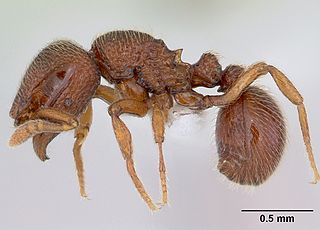
Myrmicinae is a subfamily of ants, with about 140 extant genera; their distribution is cosmopolitan. The pupae lack cocoons. Some species retain a functional sting. The petioles of Myrmicinae consist of two nodes. The nests are permanent and in soil, rotting wood, under stones, or in trees.

Dolichoderinae is a subfamily of ants, which includes species such as the Argentine ant, the erratic ant, the odorous house ant, and the cone ant. The subfamily presents a great diversity of species throughout the world, distributed in different biogeographic regions, from the Palearctic, Nearctic, Afrotropical region and Malaysia, to the Middle East, Australian, and Neotropical regions.

Anoplolepis, also known as the "pugnacious ants", is a genus of ants in the subfamily Formicinae. The genus is mainly found in the Afrotropics, with a few native species known from the Malagasy and Oriental regions.

Microdaceton is an African genus of ants in the subfamily Myrmicinae. The genus consists of four species restricted to the Afrotropics. They nest in the leaf litter and seems to be fairly common. However, little is known about their biology.

Nesomyrmex is a genus of ants in the subfamily Myrmicinae. The genus is distributed in the Neotropical, Afrotropical and Malagasy regions. Most species live in arid climates, but some are known from the rainforest. They nest in soil or in trees. Little is known about their biology.

Terataner is an African genus of arboreal ants in the subfamily Myrmicinae.

Dicroaspis is an African genus of ants in the subfamily Myrmicinae.

Melissotarsus is a rare African genus of ants in the subfamily Myrmicinae. They are known from the Afrotropics and Malagasy regions, where their nests are located in living wood, built by tunneling through the wood under the surface. They are rarely seen outside of their nests, which may contribute to their perceived rarity. However, they are considered pest insects because of damage they can cause to trees, including economically important ones such as mangos and trees in the family Burseraceae, including Aucoumea klaineana, Dacryodes buettneri, and Dacryodes edulis.

Notoncus is an Australian genus of ants in the subfamily Formicinae. The genus is known from Australia, where the ants nest in the soil or on the ground under stones and logs in forested areas. The ants are also common in gardens and parks.

Leptogenys is a genus of ants in the subfamily Ponerinae. Leptogenys is the most diverse ponerine ant genus in the world; it is widespread throughout tropical and subtropical regions and there are over 260 extant species described. Most species have ergatoid queens, and many have falcate, bowed mandibles and are specialists on isopod prey.
Dolichoderus albamaculus is a species of ant in the genus Dolichoderus. Described by Shattuck and Marsden in 2013, the species is widespread in arid regions of Australia, being found in many various habitats.
Dolichoderus angusticornis is a species of ant in the genus Dolichoderus. Described by John S. Clark in 1930, the species is endemic to Australia, found in dry scrub heath in Western Australia and South Australia. Workers are diurnal and foraging during the day and at night.
Dolichoderus canopus is a species of ant in the genus Dolichoderus. Described by Shattuck and Marsden in 2013, only two specimens of this species have been collected, which were taken from South Australia.
Dolichoderus clarki is a species of ant in the genus Dolichoderus. Described by William Morton Wheeler in 1935, the species is found in wet sclerophyll areas of the central coast of New South Wales and the Australian Capital Territory. Workers of this species are known to forage on ground and on low vegetation.
Dolichoderus etus is a species of ant in the genus Dolichoderus. Described by Shattuck and Marsden in 2013, the species is known from coastal New South Wales where it can be found in both wet and dry sclerophyll land, and they also nest in soil under rocks.
Dolichoderus formosus is a species of ant in the genus Dolichoderus. Described by John S. Clark in 1930, the species is endemic to Australia, and it is commonly found in Western Australia and South Australia. It is found in scrub like habitats, and colonies are commonly found under rocks.
Dolichoderus gordoni is a species of ant in the genus Dolichoderus. Described by Shattuck and Marsden in 2013, the species is only known from southern Queensland in Australia, mainly around forested areas.
Dolichoderus inferus is a species of ant in the genus Dolichoderus. Described by Shattuck and Marsden in 2013, the species is endemic to Australia, where it inhabits both wet and dry sclerophyll habitats and forages on low vegetation and trees.
Dolichoderus kathae is a species of ant in the genus Dolichoderus. Described by Shattuck and Marsden in 2013, the species is endemic to semi-arid regions in South Australia.
Dolichoderus omicron is a species of ant in the genus Dolichoderus. Described by Shattuck and Marsden in 2013, the species is endemic to Australia, being found in sem-arid regions and can be seen foraging during the day in columns on the ground surface. Colonies of this species can be found under rocks in soil.











